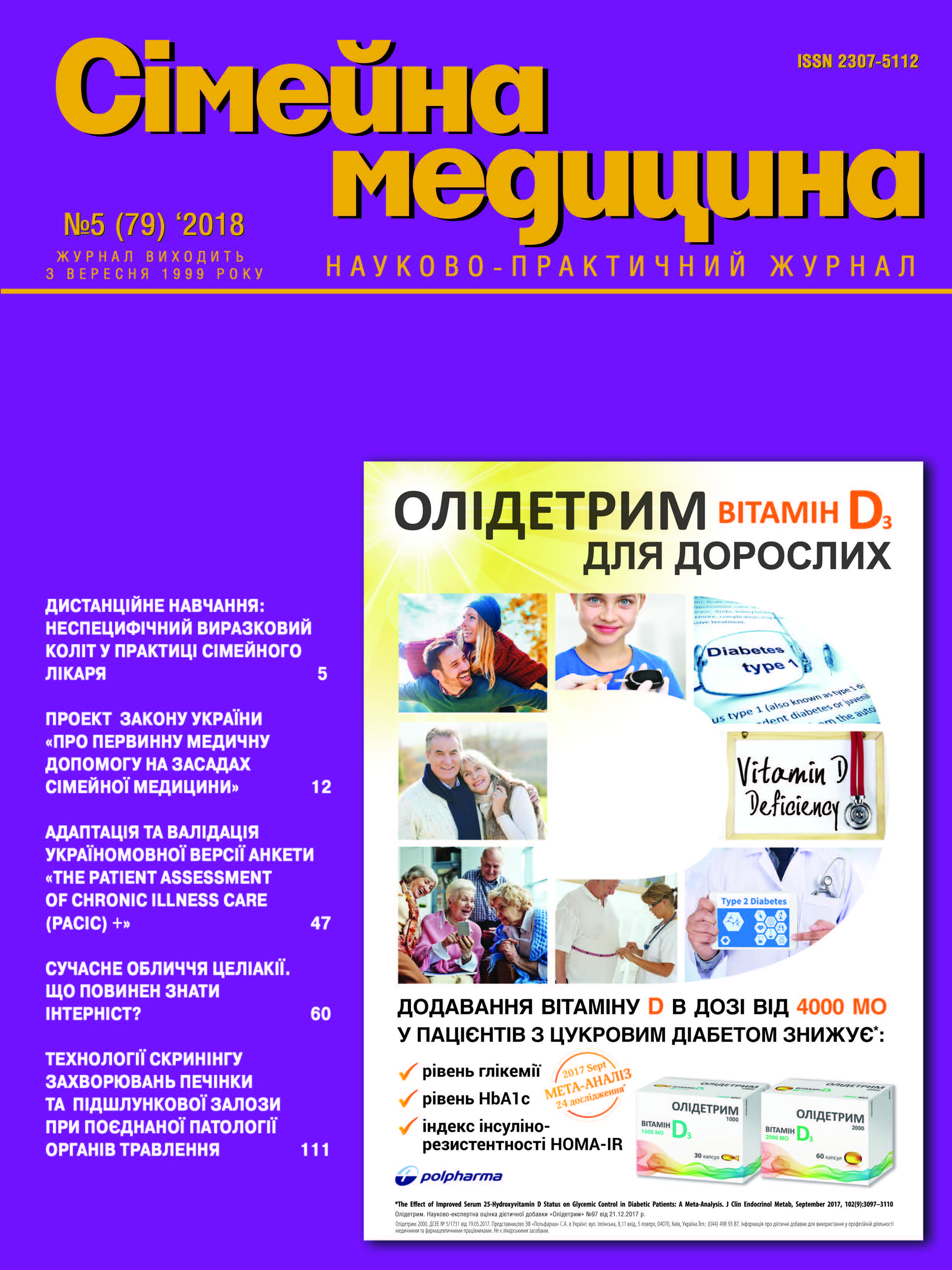Unresolved Problems in the Treatment of Arterial Hypertension and What to Do
##plugins.themes.bootstrap3.article.main##
Abstract
The emergence of numerous combinations of antihypertensive drugs in recent years creates a problem of choice for the doctor due to the lack of classification decisions in this area of hypertension.
The objective: effectiveness study of the antihypertensive combination of enalapril and indapamide (Enzix duo and Enzix duo forte, manufacturer of Hemofarm AD, Serbia) was studied in patients with high cardiovascular risk of grade II with concomitant coronary heart disease or diabetes.
Material and methods. Surveyed 28 patients randomized into 2 groups depending on the severity of the disease. To check the progress of the disease, a complex of surveys was conducted – the dynamics of clinical status, echocardiography, BP monitoring and questionnaires were studied using the 36-Hem Short-Form Health Survey (SF-36) classic questionnaire for self-assessment of quality of life.
Results. The integrated assessment of the effectiveness of the applied treatment algorithm allowed us to establish a positive dynamics of the clinical condition of the patients, the achievement of the target blood pressure level in all studied patients (after adjusting the drug dose), a statistically significant decrease in the LVMH index and average BP monitoring values.
Conclusions. The results of the study have shown that the drug combination therapy Enzix duo forte can successfully treat patients with any degree of hypertension, including patients with malignant forms, coronary heart disease, diabetes.##plugins.themes.bootstrap3.article.details##

This work is licensed under a Creative Commons Attribution 4.0 International License.
Authors retain the copyright and grant the journal the first publication of original scientific articles under the Creative Commons Attribution 4.0 International License, which allows others to distribute work with acknowledgment of authorship and first publication in this journal.
References
Hypertension: clinical management of primary hypertension in adults. National Institute for Health and Clinical Excellence. August 2011. Available at: https://www.nice.org.uk/guidance/CG127
Julius S., Kjeldsen S.E., Weber M. et.al. Outcomes in hypertensive patients at high cardiovascular risk treated with regimens based on valsartan or amlodipine: the VALUE randomized trial. Lancet 2004;363:2022–31. https://doi.org/10.1016/S0140-6736(04)16451-9
Gress T.W., Nieto F.J., Shahar E. et.al. Hypertension and anthihyperrtensive therapy as risk factors for type 2 diabetes mellitus. Atherosclerosis Risk in Commununities Study. New Engl J Med 2000;342:905–912. https://doi.org/10.1056/NEJM200003303421301
Barbagallo M., Barbagallo S.G. Efficacy and tolerability of lercanidipine in monotherapy in elderly patients with isolated systolic hypertension. Aging Clin Exp Res 2000;12(5): 375–379. https://doi.org/10.1007/BF03339863
Jamerson K.A. On behalf of the ACCOMPLISH investigators. Avoiding cardiovascular events in combination therapy in patients living with systolic hypertension //American College of Cardiology Scientific Sessions. March 31, 2008; Chicago, IL.
ESH/ESC guidelines for the management of arterial hypertension: the Task Force for the Management of Arterial Hypertension of the European Society of Hypertension (ESH) and of the European Society of Cardiology (ESC). Eur Heart J 2013;34(28):2159–2219. https://doi.org/10.1093/eurheartj/eht151
Evidence-Based Guideline for the Management of High Blood Eighth Joint National Committee (JNC). JAMA 2014;311(5): 507–520 https://doi.org/10.1001/jama.2013.284427
Эналаприл в кардиологии и терапии: стандарт эффективности и безопасности среди ингибиторов АПФ // Газета «Новости медицины и фармации» 13-14 (376–377) 2011. Full text
LeBel M., Grose J.H., Belleau L.J. et al. Antihypertensive effect of indapamide with special emphasis on renal prostaglandin production // Curr. Med. Res. Opin. 1983; 8(Suppl. 3): 81–6. http://dx.doi.org/10.1185/03007998309109841
Ettehad D., Emdin C.A., Kiran A. et. Al. Blood pressure lowering for prevention of cardiovascular disease and death: a systematic review and metaanalysis. Lancet 2016; 387:957–967. https://doi.org/10.1016/S0140-6736(15)01225-8
Costa C., Gonzalez-Alujas T., Valente F. et al. Left atrial strain: a new predictor of thrombotic risk and successful electrical cardio-version. Echo Res Pract 2016;3(2):45–52. https://doi.org/10.1530/ERP-16-0009
Zhang Y., Moran A.E. Trends in the Prevalence, Awareness, Treatment and Control of Hypertension Among Young Adults in the United States, 1999 to 2014. Hypertension 2017; 70(4):736–742. https://doi.org/10.1161/HYPERTENSIONAHA.117.09801
Mancia G., Fagard R., Narkiewicz K., et. al. 2013 ESH/ESC Guidelines for the management of arterial hypertension. The Task Force for the management of arterial hypertension of the European Society of Hypertension (ESH) of the European Society of Cardiology (ESC). J Hypertens 2013;31:1281–1357. https://doi.org/10.1097/01.hjh.0000431740.32696.cc
Gosse Р., Dubourg О., Gueret Р., et al. Efficacy of very low dose perindopril 2 mg/indapamide 0.625 mg combination on left ventricular hypertrophy in hypertensive patients: the P.I.C.X.E.L. study rationale and design. J Hum Hypertens. 2002 Sep;16(9):653–9. https://doi.org/10.1038/sj.jhh.1001467
ESC/ESH Guidelines for the management of arterial hypertension. PDF
Drapkina O.V. Quality of Life in Patients with Coronary Artery Disease. Difficult Patient 2014;7:12–16. Full text
Albert S.M., Castillo-Castenda C.D., Sano M., Jacobs D.M., Marder K., Bell K., Bylsma F., Lafleche G., Brandt J., Albert M., Stern Y. Quality of life in patients with Alzheimeris disease as reported by patient proxies. J Am Geriatr Soc 1996; 44:1342–1347. http://dx.doi.org/10.1111/j.1532-5415.1996.tb01405.x
Whelton P.K., Carey R.M., Aronow W.S. et al. 2017 ACC/AHA/AAPA/ABC/ACPM/AGS/APhA/ASH/ASPC/NMA/PCNA Guideline for the Prevention, Detection, Evaluation and Management of High Blood Pressure in Adults: A Report of the American College of Cardiology / American Heart Association Task Force on Clinical Practice Guidelines. J Am Coll Cardiol 2017 Nov 7. (Epub ahead of print). https://doi.org/10.1016/j.jacc.2017.11.006
Chen Y.W., Lin P.Y., Tu K.Y. et al. Significantly lower nerve growth factor levels in patients with major depressive disorder than in healthy subjects: a meta-analysis and systematic review Neuropsychiatr Dis Treat 2015;11:925–933. https://doi.org/10.2147/NDT.S81432
Sclaich M., Straznicky N., Lambert E., Lambert G. Metabolic syndrome: a sympathetic disease? Lancet Diabetes Endocrinol 2015;3(2);148–157. https://doi.org/10.1016/S2213-8587(14)70033-6
Gentile C., Dragomir A., Solomon C. et al. Sex differences in the prediction of metabolic burden from physiological responses to stress. Ann Behav Med 2015;49(1):112–127. https://doi.org/10.1007/s12160-014-9639-2
Arkhipenko Yu.V., Sazontova T.G., Tkatchouk E.N., Meerson F.Z. Adaptation to continuous and intermittent hypoxia: role of the active oxygen-dependent system. «Adaptation Biology and Medicine (Vol.1 Sub-cellular Basis)» (Eds. B.K. Sharma et al.) New Dehli, Narosa Publishing House 1997;251–259.





